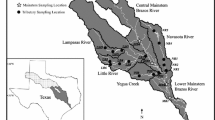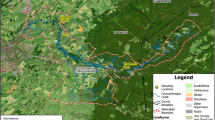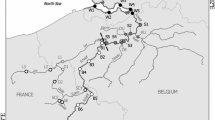Abstract
The process of wastewater treatment was studied by modeling the relationships between physical, chemical, and biological (bacteria, phytoplankton, zooplankton) components of the sewage treatment lagoons of an urban wastewater center, based upon a two-year sampling program. The models of interactions between variables were tested by path analysis. The path coefficients were computed from the results of ridge regression, instead of linear multiple regression. The results show that fecal coliforms were effectively controlled by the environmental variables included in the model, which have a cyclic seasonal behavior. This control grew stronger with distance from the input (R 2=0.71) to the output (R 2=0.88) of the treatment plant, resulting in effective elimination of most enteric bacteria. Simultaneously, the ecosystem's community of aerobic heterotrophic bacteria became more independent from the model's predictive variables, with increased distance from the sewage input, thus demonstrating its maturation as an autonomous community in the lagoon ecosystem. Consequences of modeling are discussed, with respect to the understanding of biological wastewater treatment mechanisms and ecosystem dynamics and to plant management.
Similar content being viewed by others
References
American Public Health Association (1981) Standard methods for the examination of water and wastewater. 15th ed. The Association, Washington, DC
Angeli N (1976) Influence de la pollution des eaux sur les éléments du plancton. In: La pollution des eaux continentales: incidences sur les biocénoses aquatiques. Gauthier-Villars, Paris, PP 97–133
Asher HB (1976) Causal modeling. Sage University paper series on quantitative applications in the social sciences, series no. 07-003. Sage Publications, Beverly Hills, California, p 80
Baleux B, Troussellier M (1983) Evolution des bactéries témoins de contamination fécale et dePseudomonas aeruginosa etAeromonas hydrophyla dans un ouvrage d'épuration des eaux usées par lagunage (Mèze). Tech Sci Munic 7:33–42
Bölter M, Meyer-Reil LA, Dawson R, Liebezeit G, Wolter K, Szwerinski H (1981) Structure analysis of shallow water ecosystems: interaction of microbiological, chemical and physical characteristics measured in the overlying waters of sandy beach sediments. Estuar Coast Mar Sci 13:579–589
Buhr HO, Miller SB (1983) A dynamic model of the high-rate algal-bacterial wastewater treatment pond. Water Res 17:29–37
Calkins J, Buckles JD, Moeller JR (1976) The role of solar ultraviolet radiation in “natural” water purification. Photochem Photobiol 24:49–57
Clesceri LS, Bloomfield JA (1977) General model of microbial growth and decomposition in aquatic ecosystems. Appl Environ Microbiol 33:1047–1058
Davidson FF (1961) Antibacterial activity ofOscillatoria formosa Bory extract. Water & Sewage Works 108:417–420
Davis EM, Floyna EF (1972) Bacterial dieoff in ponds. San Engng Div, Proc Am Soc Civil Engrs 98:59–69
Dixon WJ (ed) (1981) BMDP statistical software 1981. University of California Press, Berkeley
Fujioka RS, Hashimoto HH, Siwak EB, Young, RHF (1981) Effect of sunlight on survival of indicator bacteria in seawater. Appl Environ Microbiol 41:690–696
Gifi A (1984) Nonlinear multivariate analysis. DSWO Press, Leiden
Gold HJ (1977) Mathematical modelling of biological systems: an introductory guidebook. John Wiley & Sons, New York
Gravel AC, Fruh EG, Davis EM (1969) Limnological investigations of Texas impoundments for water quality management purposes: the distribution of coliform bacteria in stratified impoundments. Technical Report 38, Center for Research in Water Resources, University of Texas, Austin
Hazen TC (1983) A model for the density ofAeromonas hydrophila in Albemarle Sound, North Carolina. Microb Ecol 9:137–153
Hocking RR (1976) The analysis and selection of variables in linear regression. Biometrics 32:1–49
Hossell JC, Baker JH (1979) Epiphytic bacteria of the freshwater plantRanunculus penicillatus: enumeration, distribution and identification. Arch Hydrobiol 86:322–337
Jones JG (1971) Studies on freshwater bacteria: factors which influence the population and its activity. J Ecol 59:593–613
Jones JG (1977) The effect of environmental factors on estimated viable and total populations of planktonic bacteria in lakes and experimental enclosures. Freshwater Biol 7:67–91
Kenny DA (1979) Correlation causality. John Wiley & Sons, New York
Legendre L, Legendre P (1984) Ecologie numérique, 2e éd. Tome 2: La structure des données écologiques. Collection d'Ecologie, No. 13. Masson, Paris et les Presses de l'Université du Québec
Legendre P, Baleux B, Troussellier M (1984) Dynamics of pollution-indicator and heterotrophic bacteria in sewage treatment lagoons. Appl Environ Microbiol 48:586–593
Legendre P, Troussellier M, Baleux B (1984) Indices descriptifs pour l'étude de l'évolution des communautés bactériennes. In: Bianchi A. (ed) Bactériologie marine: colloque international no. 331. Editions du CNRS, Paris, pp 71–84
Legendre P, Dallot S, Legendre L (1985) Succession of species within a community: chronological clustering, with applications to marine and freshwater zooplankton. Am Nat 125:257–288
Lilliefors HW (1967) The Kolmogorov-Smirnov test for normality with mean and variance unknown. J Am Stat Ass 62:399–402
Mahloch JL (1974) Comparative analysis of modeling techniques for coliform organisms in streams. Appl Microbiol 27:340–345
Martin YP, Bianchi MA (1980) Structure, diversity and catabolic potentialities of aerobic heterotrophic bacterial populations associated with continuous cultures of natural marine phytoplankton. Microb Ecol 5:265–279
Martin YP, Lelong PP (1981) Modélisation de la dynamique des communautés bactériennes d'un écosystème planctonique marin expérimental. Oceanol Acta 4:433–443
McCambridge J, McMeekin TA (1981) Effect of solar radiation and predacious microorganisms on survival of fecal and other bacteria. Appl Environ Microbiol 41:1083–1087
Meyer-Reil L, Dawson AR, Liebezeit G, Tiedge H (1978) Fluctuations and interactions of bacterial activity in sandy beach sediments and overlying waters. Mar Biol (Berl) 48:161–171
Mills AL, Wassel RA (1980) Aspects of diversity measurement for microbial communities. Appl Environ Microbiol 40:578–586
Miyoshi H, Nakamoto K (1975) Factors influencing bacterial distribution in the sea of Hiuchi-Nada area. Bull Japan Soc Sci Fisheries 41:645–652
Moeller JR, Calkins J (1980) Bactericidal agents in wastewater lagoons and lagoon design. J Water Poll Control Fed 52:2442–2451
Mortimer CH (1956) The oxygen content of air-saturated fresh waters, and aids in calculating percentage saturation. Mitt Int Ver Theor Angew Limnol 6:1–20
Nie NH, Hull CH, Jenkins JG, Steinbrenner K, Bent DH (1975) SPSS—statistical package for the social sciences. 2nd ed. McGraw-Hill, New York
Niewolak S (1971) The influence of alcohol extracts of some algae (Chlorella andScenedesmus) on aquatic microorganisms. Polskie Arch Hydrobiol 18:31–42
Niewolak S (1971) The influence of living and dead cells ofChlorella vulgaris andScenedesmus obliquus on aquatic microorganisms. Polskie Arch Hydrobiol 18:43–54
Obenchain RL (1977) Classical F-tests and confidence regions for ridge regression. Technometrics 19:429–439
Oswald WJ, Gotaas HB (1955) Photosynthesis in sewage treatment. J San Engng Div, Proc Am Soc Civil Engrs 81: separate n. 686. 27 p
Palumbo AV, Ferguson RL (1978) Distribution of suspended bacteria in the Newport River estuary, North Carolina. Estuar Coast Mar Sci 7:521–529
Parhad NM, Rao NU (1974) Effect of pH on survival ofEscherichia coli. J Water Poll Control Fed 48:980–986
Pourriot R (1977) Food and feeding habits of the rotifera. Arch Hydrobiol Beih Erbegn Limnol 8:243–260
Pratt R, Daniels TC, Eiler JJ, Gunnison, JB, Kumler WD, Oneto JF, Strait LA, Spoehr HA, Hardin GJ, Milner HW, Smith JHC, Strain HH (1944) Chlorellin, an antibacterial substance fromChlorella. Science (Wash DC) 99:351–352
Rieper M (1976) Investigations on the relationships between algal blooms and bacterial populations in the Schlei Fjord (western Baltic Sea). Helgol Wiss Meeresunters 28:1–18
Rodier J (1978) L'analyse de l'eau, eaux naturelles, eaux résiduaires, eau de mer: chimie, physico-chimie, bactériologie, biologie. 6ième éd. Dunod, Paris
Schwinghamer P (1983) Generating ecological hypotheses from biomass spectra using causal analysis: a benthic example. Mar Ecol Prog Ser 13:151–166
Sokal RR, Rohlf FJ (1981) Biometry: the principles and practice of statistics in biologial research. 2nd ed. WH Freeman and Co, San Francisco
Spencer MJ (1978) Microbial activity and biomass relationships in 26 oligotrophic to mesotrophic lakes in South Island, New Zealand. Verh Int Verein Limnol 20:1175–1181
Spencer MJ, Ramsay AJ (1978) Bacterial populations, heterotrophic potentials, and water quality in three New Zealand rivers. NZ J Mar Freshwat Res 12:415–427
Troussellier M, Baleux B (1981) Approche méthodologique pour l'analyse des peuplements bactériens hétérotrophes des étangs littoraux. Acta Oecologica Oecol Gen 2:63–74
Troussellier M, Legendre P (1981) A functional evenness index for microbial ecology. Microb Ecol 7:283–296
Väätänen P (1980) Relations of selected types of micro-organisms with the vernal phytoplankton bloom in the Tvärminne area, southern coast of Finland. J Appl Bacteriol 49:463–469
Väätänen P (1982) Effects of freshwater outflows on microbial populations in the Tvärminne archipelago, southern Finland. Holarct Ecol 5:61–66
Vela GR, Guerra CN (1966) On the nature of mixed cultures ofChlorella pyrenoidosa TX 71105 and various bacteria. J Gen Microbiol 42:123–131
Wright S (1921) Correlation and causation. J Agric Res 20:557–565
Wright S (1960) Path coefficients and path regressions: alternative or complementary concepts? Biometrics 16:189–202
Author information
Authors and Affiliations
Rights and permissions
About this article
Cite this article
Troussellier, M., Legendre, P. & Baleux, B. Modeling of the evolution of bacterial densities in an eutrophic ecosystem (sewage lagoons). Microb Ecol 12, 355–379 (1986). https://doi.org/10.1007/BF02098576
Issue Date:
DOI: https://doi.org/10.1007/BF02098576




